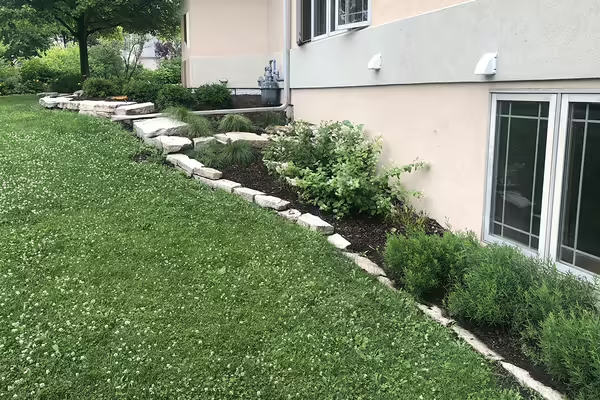
URBANA, Ill. — Residential lawns consume over 2.5 billion gallons of water a year. This makes taking a natural approach to lawn care appealing for homeowners. Also, almost 3 million tons of fertilizer are applied to residential lawns every year, and homeowners typically use three times more pesticide per acre than farmers. There are a few simple steps that landowners can take to make more environmentally sound choices when it comes to lawn care.
Healthy soil is the foundation of natural lawn care. When you return nutrients and maintain your soil, it will ultimately lead to better lawn establishment. Performing a soil test is a good place to start. Labs can test your soil chemistry for a nominal fee, and University of Illinois Extension staff can help interpret the results. Illinois Extension’s soil testing website, extension.illinois.edu/soil/soil-testing, also offers instructions about DIY tests that homeowners can do, including soil infiltration to gauge how well their soil drains. A ribbon test can assess soil texture for levels of clay, sand, and silt which is important for how different plant roots access nutrients, water, and air. You can add nutrients and other amendments based on the soil test results.
Maintenance like core aeration and recycling grassing clippings will also improve your soil. Perform core aeration when lawns are actively growing, typically in May or September. Instead of bagging up grass clippings, allow them to drop in place. Recycled clippings can provide up to 25% of nutrient needs for the lawn and add organic matter and moisture to the soil. In September, top-dress the lawn with compost or other
organic matter. In October, mow over fallen leaves to add organic matter to the soil.
While the soil is the foundation, there are other simple practices that will aid in helping the lawn grow well.
Mow high and remove no more than 1/3 of the leaf blade in one cutting. This helps to establish a deep root system and crowd out weeds. Regularly sharpen and clean your lawnmower blade.
Seed at the right time. The best time to overseed is in August, but it can also be done in May. Fill in bare spots with a 50/50 mix of soil and compost and plant perennial grass seed species that you selected based on your site conditions. Overseeding in August helps fill in bare spots and increases turf density. Seed blends or mixtures such as tall fescue for the cool season and buffalo grass for the warm season work well. Encourage the seed to germinate by keeping it evenly moist with light watering.
Limit watering and allow your lawn to go dormant. Use water efficiently and water in the early morning. Water no more than 1 inch per week, including rainfall. A rain gauge will help determine how much water is deposited. In July, reduce watering and allow the lawn to go dormant, where it will turn brown for 4 to 6 weeks. During dormancy, limit traffic and mowing and only water a ½-inch every four weeks. If you commit to letting the lawn go dormant, do not try to increase watering. It will cause too much stress on the grass.
Accept some weeds. Monitor for weeds, but some weeds are acceptable. Clover in the lawn is beneficial for bees and makes nitrogen available in the soil. If needed, remove weeds by hand or spot-treat problematic weedy areas. Use fewer toxic chemicals and consider natural and biological controls. Be sure to read and follow the pesticide label and note the best time of application.
Monitor for pests such as weeds, diseases, and insects at least twice per month. It is important to catch pests during the initial stages of development for best control. Treat problems and not symptoms. If white grubs were a problem in the past, monitor for those in July and August.
Only fertilize as needed. A soil test will help determine fertilizer needs. Fertilize medium and high-maintenance lawns in late May and again in early to mid-September. Fertilize minimal maintenance lawns from early to mid-September. Base your fertilizer program on your quality and maintenance preferences.
As you implement natural lawn care methods, monitor your successes and setbacks. Take note of what needs improvement and refer to the Illinois-Indiana Sea Grant lawn care calendar at LawntoLakeMidwest.org/calendar. For more research-based information on lawn care, connect with your local Illinois Extension county office at go.illinois.edu/ExtensionOffice.
WRITER: Nancy Kreith is a horticulture educator with University of Illinois Extension, serving Cook County. Gardeners Corner is a quarterly newsletter from gardening experts around the state. Each issue highlights best practices that will make your houseplants, landscape, or garden shine in any season. Join the Gardener’s Corner email list at go.illinois.edu/GCsubscribe for direct access to timely tips.
PHOTO ACCESS: The photo in this article is available to download for media use. Photo by Nancy Kreith.
Illinois Extension leads public outreach for University of Illinois by translating research into action plans that allow Illinois families, businesses, and community leaders to solve problems, make informed decisions, and adapt to changes and opportunities. Illinois Extension is part of the University of Illinois Urbana-Champaign College of Agricultural, Consumer and Environmental Sciences.